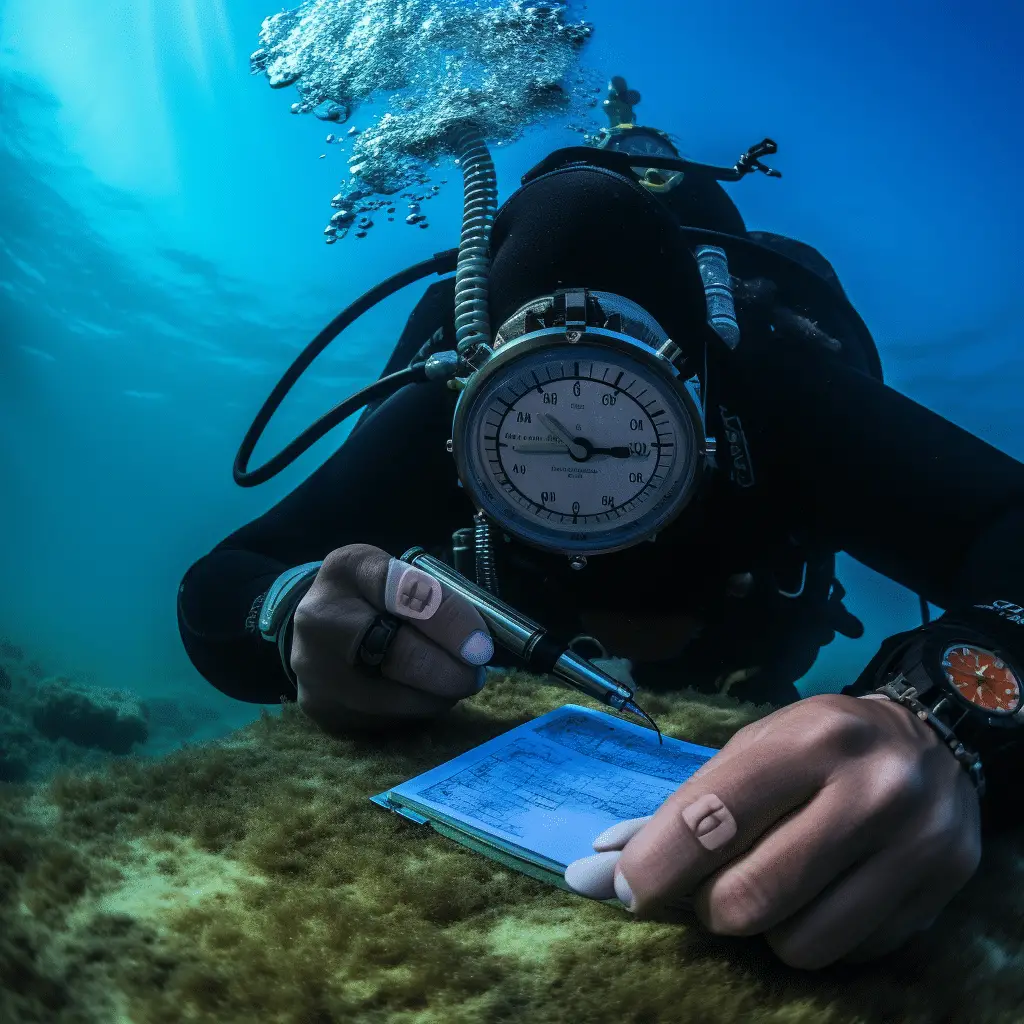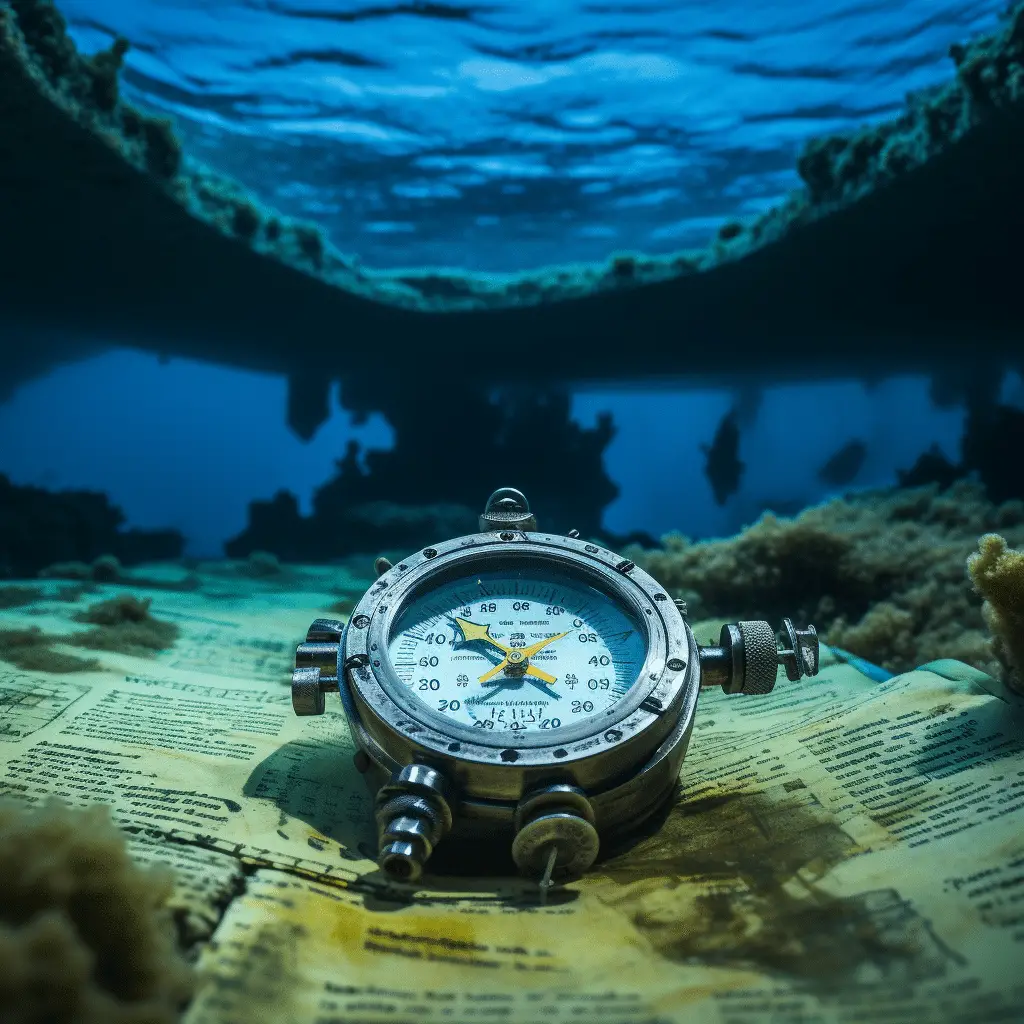Wondering how to use a dive compass? Reading a comprehensive guide on How to Use a Dive Compass will help you!
Scuba diving is an underwater sport. Some divers come upon getting lost most of the time, and they can’t find their way back.
With that said, learning the basic knowledge of using a dive compass is the solution to your upcoming dive direction adventure.
Although, learning to navigate isn’t as straightforward as most people think; because it has been done wrong for a long time.
Perhaps, navigation is a skill that always needs since each dive site is not the same as the last.
In this article, you will learn how to use a dive compass. So, without further ado, let’s get started!
What is Compass?

Compass is an instrument utilized for navigation that demonstrates direction relative to the geographic cardinal directions.
What is Diver Navigation?
Diver navigation is also known as the ‘’underwater navigation’’ by scuba divers. This is used to navigate underwater by divers to use a compass, observing natural features and surface observations.
Even though it is viewed as a fundamental skill, it is ordinarily just educated to a certain point as a feature of essential Open water courses.
Most North American diver training offices show noteworthy components of underwater navigation as a major aspect of the Advanced Open Water Diver certification program.
Underwater navigation is typically a center segment of most, if not all, progressed recreational diver training.
In the PADI Advanced Open Water Diver course. It is one of the two required aptitudes together with Deep diving, which must be taken close by three elective skills.
Preparing organizations to advance underwater navigation; as an aptitude regardless of the way that it is less well known; than other recreational plunging specialties on the premise that it:
- Fabricates diver’s certainty.
- Saves energy by minimizing excess swimming
- It makes dive planning more effective.
- Keeps dive mates together
- Lessens air consumption
Underwater compass navigation is a segment of the scuba-based underwater sport and underwater orienteering.
Uses of Natural Features
- Landmarks
- Depth and depth variation.
- The angle of the sun changes in the light level.
- Current, wave, and surge direction.
- Ripple patterns on a sand bottom.
- Dip and strike of bedrock.
- Ecological variations.
Structures of a Compass
The Card
This is the heart of the compass, which is also known as the ‘’north needle’’.
This round bit of attractive material buoys inside the body of the compass and consistently focus north. Look simple, an uncluttered presentation with the cardinal focuses and unadorned tick—checks between those focuses. However, the card may have degree numbers imprinted on it.
As long as the compass is being held in level and the compass card can turn freely. The needle will point to the magnetic north.
The Bezel
The bezel is the part that surrounds the car with the degree headings.
Bezel’s important features are the two index marks, which are meant to align the north needle; opposite to these, most compasses will have a reciprocal mark used to the starting point.
This is a ring you can turn to stamp your course, normally by confining the situation of north on the card.
The bezel might be the greatest wellspring of disarray in the numeric compass route because there are two styles, direct perusing and circuitous perusing. They show headings in various manners.
The Lubber Line
Another important feature of the compass the lubber line, also known as the ‘’centerline’.
One of its key features is to always keep the compass’s centerline in line with the centerline of the body.
A lubber line on the body is only a sight to help you point and point the compass.
Side Reading Window
Many divers prefer to use their compasses side reading window.
This is a relatively simple mechanism. A single index mark allows you to read the direction in which the compass is pointed in degrees.
An increasingly popular type of compass is the; digital compass, which has a feature built into many dive computers that exactly works on how it varies, make, and model. In general, they work very much like a side reading mechanically.
A side-see window permits you to hold the compass between your destination and your eye and read your course.
However, this regularly requires an extra (read: befuddling) set of numbers. Furthermore, you can see just numbers, no tick marks, through the little window.
3 Things Involves in Using a Compass
Setting the Compass
- Start aiming your compass at your intended destination.
- Allows the north needle to settle.
- Rotate the bezel can match the index marks to the north needle.
When the index marks are aligned in the north needle, you will know that the compass point is in the right direction.
Holding the Compass
The big factor in how you hold your compass is how the compass is mounted. Meaning that compass mounting is to have the compass on an instrument consoling these offers numbers of benefits, including;
- It is easy to hold and keep it aligned at the center of your body.
- Allows you to monitor depth at the same time as you do the direction.
- You can easily adjust buoyancy with your remaining hand.
Following the Compass
It is fairly easy when it comes to following a simple mechanical compass underwater.
- Just keep the compass level because if it is not level properly, the compass car can lock up and not turn.
- Align the centerline of the compass with the centerline of your body.
- Turn until the north needle is centered in the index mark.
- Keep the needle in the index mark while you swim.
How to Use a Dive Compass
During your PADI Open Water Course, you would have aced two route aptitudes, one on the surface and one on the underwater. It might have been some time prior that you did this, so here are a couple of updates:
Hold It Correctly
The compass ought to be held straightforwardly, before you with the lubber line directly in the focal point of your body. The compass ought to be impeccably level significance and not tilted either to one side, right, advances or back.
Set the Heading
You should point the loafer line in your ideal bearing; you should then turn the bezel with the goal that the north bolt sits straightforwardly; in the middle of the 2 record marks. Observe the number of degrees on the bezel for your bearing.
Swim
It would help if you then swam out gradually, checking your blade kicks. Recollect checking one leg during the stroke. Keep the North bolt in the middle of the record imprints. Make a beeline for where you need to go. Simple!
Sounds sufficiently straightforward. However, there are a couple of tips and deceives to cause it significantly simpler while you explore.
This will mean you can make the most of your dive more glance around and spot marine life obviously if essential, get securely back to the vessel.
Get ready
On the off chance that it has been some time since you last utilized a compass practice ashore first. Reorient yourself with the various highlights of the compass and how to set headings. Convey a record and pencil on your plunge. This will allow you to note down any headings you intend to use before the dive. If there is any disarray underwater, you can utilize the record to speak with your amigo.
Glance Around
Don’t simply gaze at the compass. Observe your environment.
Also, to the fact that you are going to see increasingly marine life. You can look out for flows and utilize normal references.
In the wake of setting your underlying heading, you should glance around to check whether there are any common highlights, for example, rock or coral arrangements.
After setting off, you should keep in mind the component to ensure you are on course and no flows are pushing you off.
Careful Discipline Brings About Promising Results

If you need to be gotten increasingly capable with the compass, you should take your Advanced open waterway at that point. During this course, there is a whole Adventure diving devoted to Underwater Navigation.
You will figure out how to play out a square underwater; utilize a normal route just as strategies to gauge separation underwater. Likewise, you will rehearse a proportional heading, like what you did on your open watercourse. As many say, “practice makes perfect.”
Buy Compass
Purchasing your own compass is just going to make you progressively comfortable and alright with it. Suunto SK8 is the most mainstream compass on the planet.
This can be fitted onto your SPG, worn on your wrist, or joined to your BCD associated with a retractable string.
You can even utilize it late diving. The body of the compass retains your light and becomes luminescent, allowing you to explore in obscurity.
There are lots of available diving compass on Amazon.
Keep It Simple
There is no compelling reason to make things harder than they must be. Attempt simply utilizing the primary concerns on the compass North, South, East, or West for headings.
Doing this implies you don’t need to stress over recollecting a particular degree’s course; and improves the entire procedure of getting around a plunge site.
Practice
The PADI Underwater Navigator course will test your compass aptitudes; to the maximum and reinforce your certainty to utilize a compass and underwater navigation all in all.
When you have finished this 3 plunge PADI Specialty course, you would have had the option to explore around a jump site utilizing different headings. You will even have the option to outline the dive site.
After this, your dive mates will believe in you to lead a dive and; make it back to the vessel toward the end.
Conclusion:
Learning how to navigate a dive compass is one of the most fundamental skills that divers need.
Having basic skills and advance knowledge in using a dive compass; will lead your way to have a full of fun and enjoyment underwater adventure.
Hopefully, this article helps you and gives you additional knowledge and the guidelines that you can apply on how to use your diving compass.
